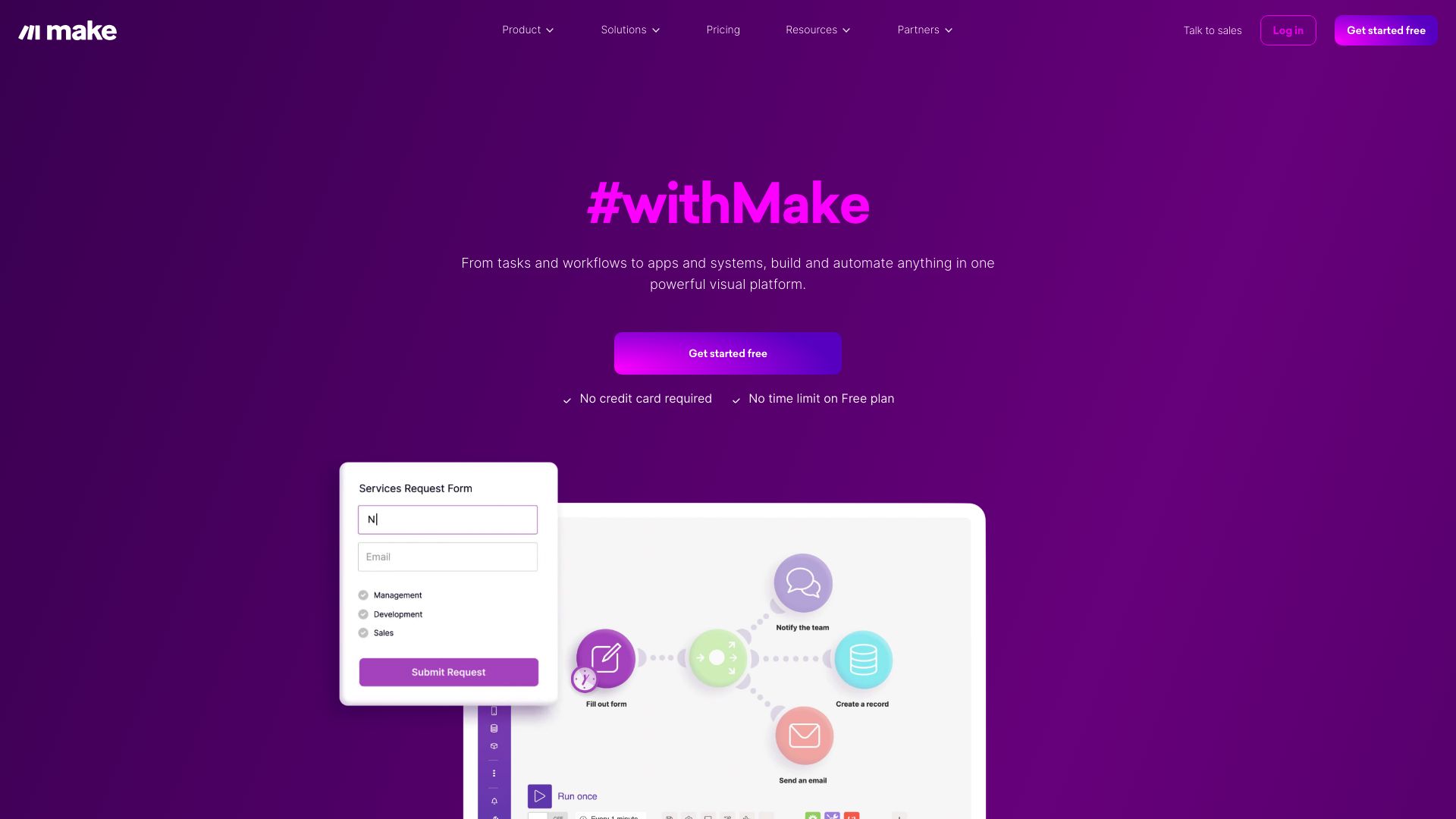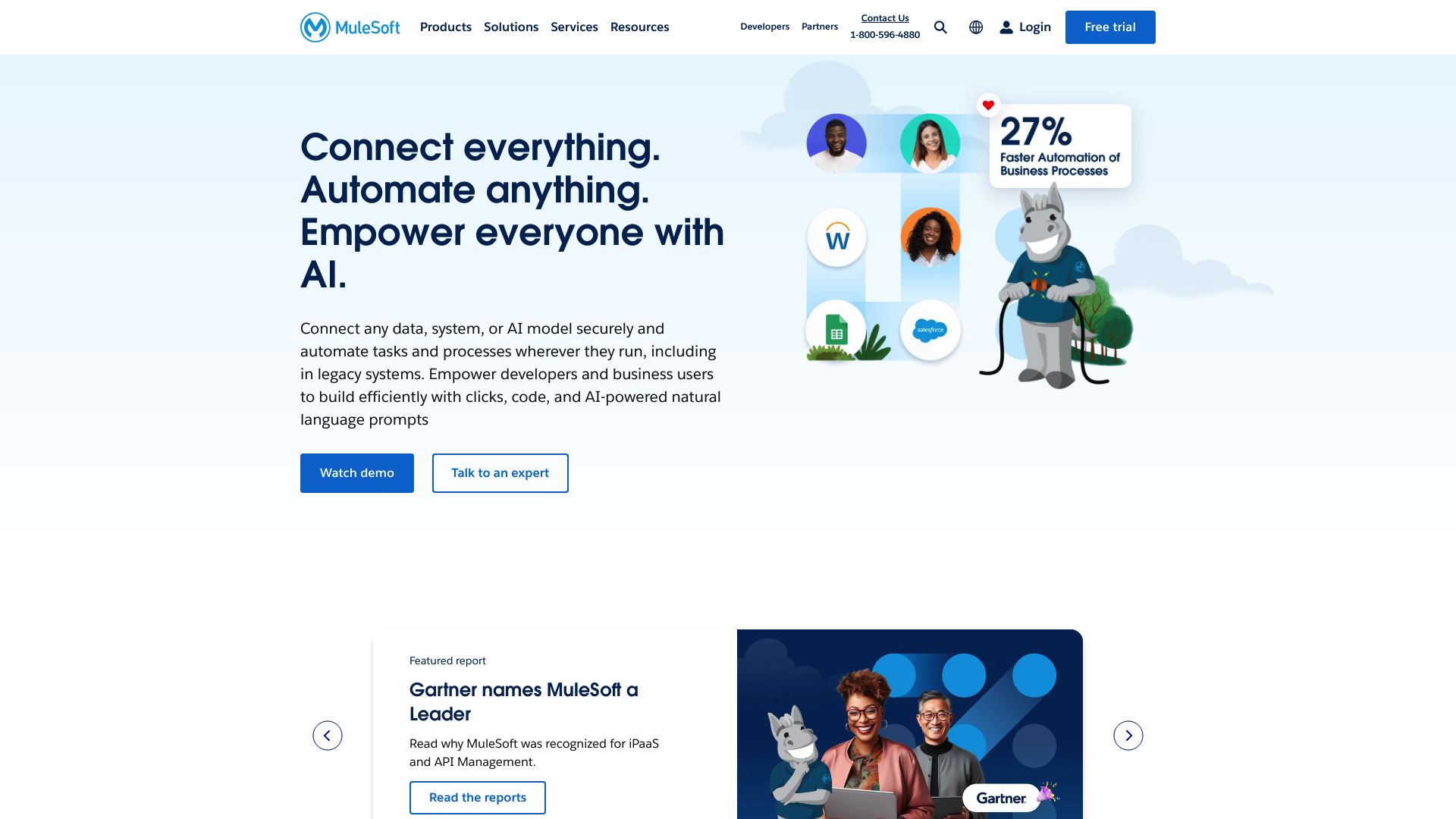Make.com vs. Mulesoft: AI Integration Platforms Compared
AI integration platforms have become essential tools for businesses seeking to harness the power of artificial intelligence. Make.com vs. Mulesoft stand out as popular choices, each offering unique approaches to workflow automation and system integration. This comparison explores their key features, strengths, and limitations, while introducing SmythOS as a compelling alternative.
We’ll delve into how these platforms tackle AI integration, examine their user interfaces, and assess their suitability for different business needs. Whether you’re a developer looking for robust API management, a business leader focused on scalability, or a non-technical user seeking intuitive automation tools, this analysis will help you navigate the landscape of AI-powered integration platforms and make an informed decision for your organization.
Make.com Overview
Make.com empowers users to create sophisticated automation workflows without coding skills. The platform’s visual builder allows drag-and-drop creation of scenarios that connect over 1000 apps and services.


Make.com excels at streamlining repetitive tasks and data flows between applications. Users can build complex integrations visually, schedule automated workflows, and process data in bulk. The platform offers robust tools for transforming and manipulating data as it moves between connected services.
Make.com empowers users to create sophisticated automation workflows without coding skills. The platform’s visual builder allows drag-and-drop creation of scenarios that connect over 1000 apps and services.
While Make.com provides powerful automation capabilities, it lacks some advanced AI features found in dedicated agent builders. The platform does not offer hosted AI agents, autonomous agents, or built-in natural language processing. However, it can integrate with external AI services to incorporate some AI functionality into workflows.
Make.com’s strength lies in its extensive library of pre-built app connections and its intuitive scenario builder. This allows even non-technical users to create sophisticated integrations. The platform also provides collaboration features for teams, detailed execution logs for debugging, and the ability to scale from personal projects to enterprise-grade solutions.
For businesses looking to automate workflows and connect disparate systems, Make.com offers a compelling solution. However, those seeking to build advanced AI agents may find its capabilities more limited compared to specialized AI development platforms. Make.com’s focus on accessibility and integration makes it well-suited for automating business processes, even if it doesn’t match the AI capabilities of dedicated agent builders.
Mulesoft Overview
Mulesoft delivers a comprehensive integration platform designed to connect data, applications, and devices across on-premises and cloud computing environments. The Anypoint Platform enables organizations to design, build, and manage APIs, integrations, and automations with ease.


Mulesoft’s flagship product, the Anypoint Platform, offers full-lifecycle API management capabilities. Developers can rapidly create APIs using visual tools or code, deploy them securely, and monitor their performance in real-time. The platform’s API-led connectivity approach promotes reusability and efficiency, allowing businesses to build a network of interconnected APIs and applications.
Mulesoft’s flagship product, the Anypoint Platform, offers full-lifecycle API management capabilities. Developers can rapidly create APIs using visual tools or code, deploy them securely, and monitor their performance in real-time.
For enterprises grappling with AI integration, Mulesoft provides robust tools to connect data silos and enhance AI-driven processes. The platform’s Einstein AI integration capabilities enable natural language interfaces for project initiation and intelligent data mapping, significantly boosting developer productivity. Mulesoft’s emphasis on security and governance, exemplified by the Anypoint Flex Gateway, ensures that API management remains secure and controlled—a critical factor for organizations handling sensitive data in AI applications.
While Mulesoft excels in enterprise integration and API management, it lacks some of the advanced AI agent functionalities found in dedicated AI platforms. The absence of features like autonomous agents, multimodal capabilities, and built-in problem-solving AI limits its applicability in certain AI-centric use cases. However, for organizations primarily focused on integrating AI into existing systems and workflows, Mulesoft’s robust integration capabilities and security features make it a strong contender in the market.
Feature Comparison
Make.com and Mulesoft offer robust integration platforms with distinct capabilities and limitations. Make.com excels in providing an intuitive visual workflow builder for connecting apps and automating processes without coding. Its drag-and-drop interface and extensive library of pre-built integrations make it accessible for non-technical users. However, Make.com lacks advanced AI capabilities like hosted agents, autonomous agents, or built-in natural language processing.
Mulesoft, on the other hand, focuses on enterprise-grade API management and integration. Its Anypoint Platform enables full lifecycle API development, deployment, and monitoring. Mulesoft’s emphasis on security and governance, exemplified by features like Anypoint Flex Gateway, ensures controlled API management crucial for organizations handling sensitive data. While Mulesoft provides tools for AI integration, such as Einstein AI for natural language interfaces and intelligent data mapping, it doesn’t offer dedicated AI agent functionalities like autonomous agents or multimodal capabilities.
The core components of these platforms highlight significant gaps. Make.com’s strength lies in its user-friendly automation tools, whereas Mulesoft’s power comes from its comprehensive API management features. Neither platform provides the advanced AI agent capabilities found in specialized AI development environments. In terms of security, Mulesoft’s enterprise focus results in more robust offerings, including advanced API governance and security measures, while Make.com’s security features are more basic, tailored to its broader user base.
Feature Comparison Table
| Make.com | Mulesoft | SmythOS | |
|---|---|---|---|
| CORE FEATURES | |||
| AI Agents | ❌ | ✅ | ✅ |
| Hosted Agents (Dev, Production) | ❌ | ✅ | ✅ |
| Environments (Dev, Production) | ❌ | ✅ | ✅ |
| Memory & Context | ❌ | ❌ | ✅ |
| Autonomous Agents | ❌ | ✅ | ✅ |
| Explainability & Transparency | ❌ | ❌ | ✅ |
| Multimodal | ❌ | ✅ | ✅ |
| Problem-Solving Capabilities | ❌ | ❌ | ✅ |
| Multi-Agent Collaboration | ❌ | ✅ | ✅ |
| Human-AI Interaction | ❌ | ❌ | ✅ |
| Audit Logs for Analytics | ✅ | ❌ | ✅ |
| SECURITY | |||
| Constrained Alignment | ❌ | ✅ | ✅ |
| Data Encryption | ❌ | ❌ | ✅ |
| IP Control | ❌ | ✅ | ✅ |
| COMPONENTS | |||
| Foundation AIs | ❌ | ✅ | ✅ |
| Huggingface AIs | ❌ | ❌ | ✅ |
| Zapier APIs | ❌ | ❌ | ✅ |
| All other APIs, RPA | ✅ | ❌ | ✅ |
| Classifiers | ❌ | ✅ | ✅ |
| Logic | ✅ | ❌ | ✅ |
| Data Lakes | ❌ | ✅ | ✅ |
| DEPLOYMENT OPTIONS (EMBODIMENTS) | |||
| Deploy as API | ❌ | ✅ | ✅ |
| Staging Domains | ❌ | ✅ | ✅ |
| Production Domains | ❌ | ✅ | ✅ |
| Deploy as Site Chat | ❌ | ✅ | ✅ |
| Deploy as Scheduled Agent | ✅ | ❌ | ✅ |
| Scalability | ✅ | ❌ | ✅ |
| DATA LAKE SUPPORT | |||
| Hosted Vector Database | ❌ | ✅ | ✅ |
| Sitemap Crawler | ❌ | ❌ | ✅ |
| YouTube Transcript Crawler | ❌ | ❌ | ✅ |
| URL Crawler | ❌ | ❌ | ✅ |
| PDF Support | ❌ | ❌ | ✅ |
| Word File Support | ❌ | ✅ | ✅ |
| TXT File Support | ❌ | ✅ | ✅ |
Best Alternative to Make.com and Mulesoft
SmythOS emerges as the superior alternative to Make.com and Mulesoft, offering a comprehensive AI automation platform that addresses the limitations of both competitors. Our platform combines the ease of use found in Make.com with the enterprise-grade capabilities of Mulesoft, while surpassing both in AI-specific features and flexibility.
Unlike Make.com’s basic automation tools or Mulesoft’s API-centric approach, SmythOS provides a full suite of AI agent capabilities. We offer hosted agents for both development and production environments, enabling seamless transitions from testing to deployment. Our visual builder simplifies the creation of complex AI workflows, making advanced automation accessible to users of all skill levels.
SmythOS excels in areas where Make.com and Mulesoft fall short. We provide robust memory and context management, allowing AI agents to maintain coherent, context-aware interactions. Our platform supports autonomous agents capable of complex problem-solving and multi-agent collaboration, features absent in Make.com and limited in Mulesoft. Additionally, SmythOS offers superior explainability and transparency, crucial for building trust in AI systems.
SmythOS excels in areas where Make.com and Mulesoft fall short. We provide robust memory and context management, allowing AI agents to maintain coherent, context-aware interactions.
Security and scalability set SmythOS apart. We implement advanced features like constrained alignment and data encryption, ensuring AI behaviors align with organizational goals while protecting sensitive information. Our platform scales effortlessly to meet growing demands, offering deployment options as APIs, webhooks, site chats, and scheduled agents. This versatility, combined with our extensive integration capabilities, allows SmythOS to adapt to virtually any use case or industry requirement.
By choosing SmythOS, businesses gain access to a cutting-edge AI platform that not only matches but exceeds the capabilities of Make.com and Mulesoft. Our solution empowers organizations to harness the full potential of AI, driving innovation and efficiency across all operations.
Conclusion
Make.com and Mulesoft offer powerful integration capabilities, each excelling in different areas. Make.com provides an intuitive visual builder for creating complex workflows without coding, ideal for businesses seeking to automate processes across multiple apps. Mulesoft, with its robust API management and enterprise-grade features, caters to organizations requiring sophisticated integrations and data governance.
However, SmythOS emerges as the superior choice, particularly for businesses looking to leverage advanced AI capabilities. Unlike Make.com and Mulesoft, SmythOS offers a comprehensive suite of AI-focused features, including hosted agents, autonomous operations, and multimodal interactions. These capabilities enable businesses to create intelligent, self-operating systems that can handle complex tasks and decision-making processes.
SmythOS’s drag-and-drop interface, combined with its extensive integration ecosystem, allows for rapid development and deployment of AI agents across various platforms. This versatility, coupled with features like multi-agent collaboration and problem-solving capabilities, positions SmythOS as a more future-proof solution for businesses aiming to stay ahead in the AI-driven landscape.
For organizations ready to harness the full potential of AI in their operations, SmythOS offers a risk-free opportunity to explore its capabilities. With a free account option and a 30-day money-back guarantee, businesses can experience firsthand how SmythOS can transform their workflows and drive innovation. Discover the power of AI-driven automation and integration by getting started with SmythOS today.
Last updated:
Disclaimer: The information presented in this article is for general informational purposes only and is provided as is. While we strive to keep the content up-to-date and accurate, we make no representations or warranties of any kind, express or implied, about the completeness, accuracy, reliability, suitability, or availability of the information contained in this article.
Any reliance you place on such information is strictly at your own risk. We reserve the right to make additions, deletions, or modifications to the contents of this article at any time without prior notice.
In no event will we be liable for any loss or damage including without limitation, indirect or consequential loss or damage, or any loss or damage whatsoever arising from loss of data, profits, or any other loss not specified herein arising out of, or in connection with, the use of this article.
Despite our best efforts, this article may contain oversights, errors, or omissions. If you notice any inaccuracies or have concerns about the content, please report them through our content feedback form. Your input helps us maintain the quality and reliability of our information.
